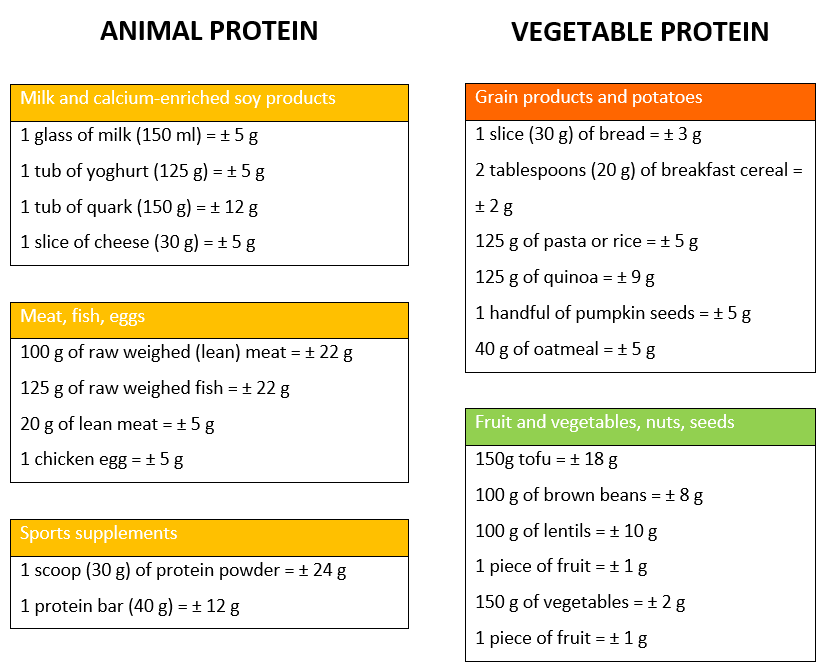Checkout using your account
Checkout as a new customer
Creating an account has many benefits:
- See order and shipping status
- Track order history
- Check out faster
How much protein do I need to build muscle?
It is familiar to anyone who ever visits a gym: protein is extremely popular in sports/fitness. Whether this is to stimulate muscle building or to enhance muscle recovery, various kinds of high-protein products are often staples in the daily diet. But, how much protein do you need to build muscle? At what times during the day should protein be consumed? And what about other cure-alls that can boost muscle building? In the following four blogs, you can read about the science behind this ‘protein hype’. In part 1 of this blog series, we will discuss the ideal amount and quality of protein required to optimise muscle building.
Two processes are simultaneously at work in our muscles 24 hours a day: these are muscle building and muscle breakdown, which occur via protein building and protein breakdown, respectively. The balance between these two processes determines whether or not our muscles will grow: muscle mass will only actually increase if the balance is positive, i.e. protein building exceeds protein breakdown. In the opposite case, muscle mass will decline. Strength training stimulates both processes and thus is not sufficient to provide muscle growth by itself. However, consuming sufficient protein with the goal of supplying amino acids to the muscles will ensure that muscle building is significantly stimulated, which creates a positive balance. So, combining training stimuli and sufficient protein is required to ensure the optimal growth of muscle mass.
Quantity
The recommended amount of protein to consume each day in a normal diet is 0.8 to 1 gram per kilogram of body weight. For someone weighing 70 kilograms, this is about 56 to 70 grams per day. This is really easy to attain with normal foodstuffs (see Table 1 below). However, in recent years, it has become clear that this recommendation is not really optimal for people who exercise regularly. A higher consumption is necessary each day in order to maintain muscle mass via muscle recovery after exercise and to eventually build muscle mass. If building muscle mass through (intensive) strength training is the primary goal, then the optimal daily amount of protein to consume increases to about 1.6 grams of protein per kilogram of body weight each day. If you also want to lose weight (i.e. reduce fat), it can be even 2 grams per kilogram of body weight each day. To be absolutely sure that you are consuming sufficient protein, you can include a ‘safety margin’ and increase consumption to a maximum of 2.2 grams of protein per kilogram of body weight each day. So, for someone weighing 70 kilograms, this would be 112 grams to a maximum of 154 grams each day. However, do not forget that extra protein also means extra calories. So, you will need to reduce the amount of carbohydrates and fats elsewhere in your diet.
Consuming extra protein is too often only associated with strength sports and muscle mass. In fact, protein consumption is also crucial in endurance sports to obtain optimal benefits from exercise. An (endurance) athlete for whom muscle building and recovery after exercise is most important, the guideline is 1.2 to 1.6 grams of protein per kilogram of body weight each day. So, for someone weighing 70 kilograms, this would be 84 grams to a maximum of 112 grams each day. Table 1 shows various examples of products that will help you satisfy this daily requirement. The larger the daily requirement, the more difficult it will be to consume all of the required protein from regular foodstuffs. Protein shakes or other protein-enriched products are a solution. In fact, a protein shake is really easy to grab after exercise or a competition compared to something like a tub of quark or a piece of chicken.

Tabel 1: Examples of the quantity of animal or vegetable protein in various foods.
Quality
In addition to the total amount of protein in a day, the quality of the protein is also important. In fact, not all protein is equally good at stimulating muscle building. The amino acids composition of protein is crucial: the greater the amount of essential amino acids (amino acids that cannot be made easily by the body), the higher the quality of the protein. For example, whey protein (e.g. from cheese, quark, or many protein shakes) has a much higher quality than soy or casein protein. Dairy products based on cows milk (which contains a lot of whey protein) is significantly more effective in stimulating muscle building than milk substitutes, such as milk made from rice, oats, coconut, or almonds (which do not contain whey protein). The most important rule of thumb is that animal products (e.g. meat, fish, dairy, or eggs) generally are of a higher quality than vegetable products (e.g. nuts, grains, soy, or legumes). Animal protein also has a higher level of the essential amino acid leucine, which plays an important role in stimulating muscle recovery and muscle building.
The third guideline for the daily recommended amounts applies to protein of a high quality. A lower quality is not per se worse for muscle building, but the lower quality must be compensated by increasing the total amount consumed. However, this adds more calories than might be desirable. Table 1 shows that vegetable products can be a good supplement for the daily amounts of protein required provided that the total amount consumed is increased.
Summary
To build muscle mass, you must combine strength training with a sufficient amount of protein. If you are attempting to increase muscle mass using strength training, the recommended amount of protein is between 1.6 and 2.2 grams per kilogram of body weight each day. For athletes who do not want to build muscle, but rather attain optimum recovery, the recommended amount is between 1.2 and 1.6 grams per kilogram of body weight each day. In this case, it is recommended that you consume ‘high-quality’ protein (i.e. animal products). If mostly vegetable protein is consumed, the total amount consumed should be increased. The next blog of this series will discuss the optimal distribution of the total amount of protein throughout the day.
References
-
Stokes T, Hector AJ, Morton RW, McGlory C, Phillips SM.
Recent Perspectives Regarding the Role of Dietary Protein for the Promotion of Muscle Hypertrophy with Resistance Exercise Training. Nutrients, 10(2), E180, 2018.
https://www.ncbi.nlm.nih.gov/pubmed/29414855 -
Campbell B, Kreider RB, Ziegenfuss T, La Bounty P, Roberts M, Burke D, Landis J, Lopez H, Antonio J.
International Society of Sports Nutrition position stand: protein and exercise. Journal of the International Society of Sports Nutrition, 4(8), 2007.
https://jissn.biomedcentral.com/articles/10.1186/1550-2783-4-8 -
Van Vliet S, Burd NA, van Loon LJ
The Skeletal Muscle Anabolic Response to Plant- versus Animal-Based Protein Consumption. The Journal of Nutrition, 145(9), p1981-1991, 2015.
https://www.ncbi.nlm.nih.gov/pubmed/26224750
